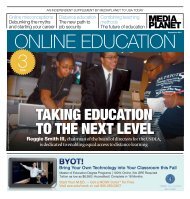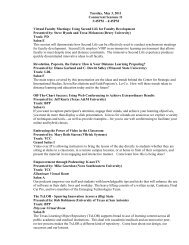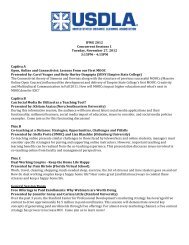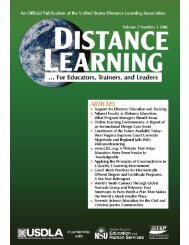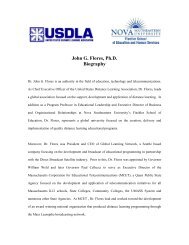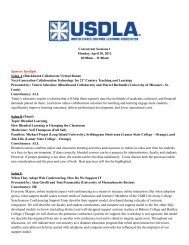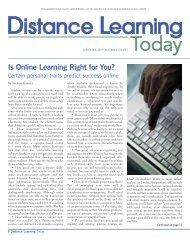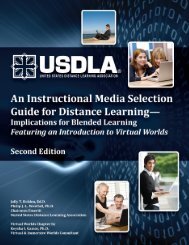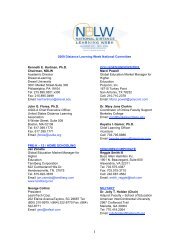United States Distance Learning Association
United States Distance Learning Association
United States Distance Learning Association
- No tags were found...
You also want an ePaper? Increase the reach of your titles
YUMPU automatically turns print PDFs into web optimized ePapers that Google loves.
gestions with the student and her colleagues<br />
in the UAE. It made for very<br />
powerful and relevant learning, although<br />
quite different in content from what I had<br />
originally prepared at the start of the week.<br />
As I have become more familiar with the<br />
technological possibilities of online interactive<br />
linked distance learning, I have<br />
become increasingly excited and intrigued<br />
with its potential to help create formal,<br />
diverse, connected learning communities.<br />
Developing an ecological worldview in<br />
part involves a blurring of perceptual borders<br />
between where definitions of “local”<br />
and “global” begin and end, particularly in<br />
terms of environmental impact. Geographically<br />
and/or culturally disparate learners<br />
can use on-line technology to share their<br />
knowledge, experiences, and discussions;<br />
create perceptual immediacy and intimacy;<br />
and in the process actively contribute<br />
to course content.<br />
There are numerous examples of how<br />
this is being approached in formal and<br />
informal learning, with students of all<br />
ages, from K-12 to postgraduate. At the K-<br />
12 end of the spectrum, there is the Finnish-based<br />
ENO “Environment Online,” a<br />
global virtual school for sustainable development<br />
and environmental awareness.<br />
This can be found on the Web at<br />
http:eno.joensuu.fi/basics/briefly.htm<br />
Another such example is iEARN (http://<br />
www.iearn.org), “the world’s largest nonprofit<br />
global network that enables teachers<br />
and young people to use the Internet and<br />
other new technologies to collaborate on<br />
projects that both enhance learning and<br />
make a difference in the world” (para. 1).<br />
TakingITGlobal is a relevant e-learning<br />
site that I recently used for e-linking<br />
groups of students from two universities<br />
internationally (NSU in Florida, and the<br />
University of Guelph in Canada). TakingITGlobal<br />
(TIG) is a nonprofit international<br />
organization founded and led by<br />
youth. It uses Web-based technology to<br />
connect a target-base of youth 13 to 30<br />
from around the world (130,000 members<br />
in over 200 countries) to learn about crosscultural<br />
issues and perspectives, so that<br />
they may be empowered to take “tangible<br />
action” (TakingITGlobal, 2006) to improve<br />
their local and global communities.<br />
Regional membership breakdown is notable<br />
in terms of equity of access and voice<br />
across the global North and South. For<br />
2005, the highest percentage (28.9%) was<br />
North America, followed by Africa (22.2%),<br />
Asia (21%), Europe (13%), and the remainder.<br />
The organization’s simple mantra is to<br />
inspire, inform, involve. TIG promotes<br />
socially and environmentally responsible<br />
entrepreneurship and engagement<br />
through technology, communication, collaboration,<br />
and community. Its Web site is a<br />
multifaceted hub where members interact,<br />
learn and report at a local and global level.<br />
Information and communication technologies<br />
are explicitly recognized as a major<br />
resource by TIG. The organization is selfdescribed<br />
as “led by youth, empowered by<br />
technology.” The use of the technologies is<br />
not passive, but mandated to be “meaningful”<br />
in terms of bringing about positive<br />
change. Educators can take advantage of<br />
the TIGEd site embedded within TakingIT-<br />
Global to create open or closed classrooms<br />
with the potential for asynchronous discussions,<br />
chats, file uploading, blogs, and<br />
the advantage of being able to collaborate<br />
easily with other TIGEd educators and the<br />
broad TIG member community.<br />
Professor and educator David Orr is<br />
chair of the environmental studies program<br />
at Oberlin College, Ohio. He is the<br />
author several books and numerous<br />
papers on environmental literacy in higher<br />
education, and renowned for his work in<br />
ecological design. In an interview in London,<br />
England in June 2005, he mused that:<br />
Education is about educing qualities in<br />
students … the role then of teaching is<br />
the role in a way of being a broker, of<br />
being a catalyst, but it’s not the old banking<br />
model of education where poor,<br />
young, ignorant, and empty minds come<br />
38 <strong>Distance</strong> <strong>Learning</strong> Volume 4, Issue 4



